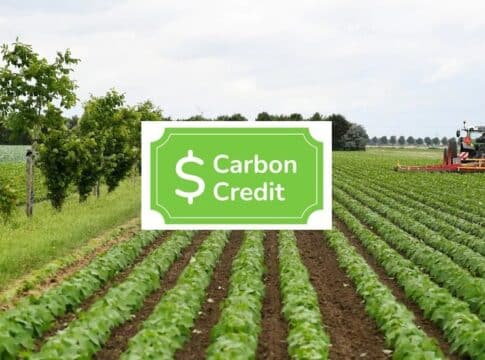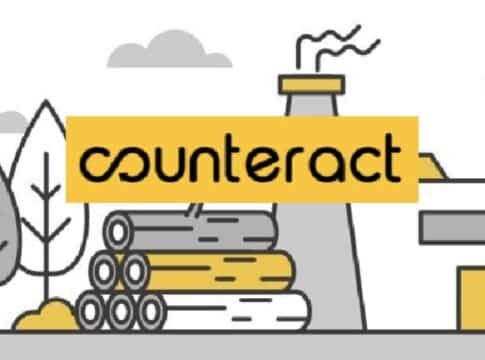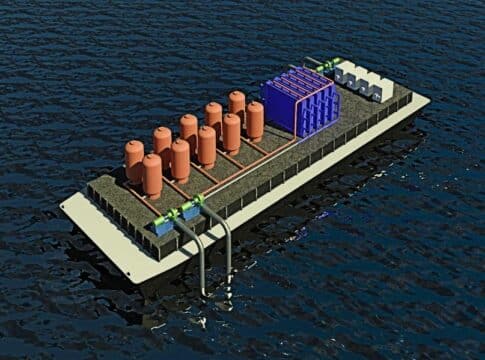Carbon Credits Farming (Everything You Need To Know)
If you’re looking for new ways to make your farm profitable, generating carbon credits from farming has been the go-to solution that farmers opt for.
That’s not surprising given that carbon farming enhances the organic matter content in the soil, minimizes costs, and gives extra income through carbon credits. Not to mention that it may also give farmers access to better financial incentives from banks or institutional investors.
With growing demand from businesses to buy carbon credits from farmers, it is now clear why carbon farming will be the future of agriculture. But some farmers are still in the dark when it comes to agricultural carbon credits.
And so the purpose of this article is to help clarify things by explaining how carbon credits in farming works, why it matters, and what are the key considerations you should make.
How Does Carbon Credits in Farming Work?
But first things first, let’s define what a carbon credit is.
The idea behind carbon credits is that entities responsible for emitting CO2 have to reduce their emissions or pay for the efforts of farmers or others who are doing the work of removing CO2 from the air. The payment is in the form of a carbon credit, with each credit representing one metric ton of carbon reduced or removed.
Crops, grasses and other plants sequester CO2 from the air but they also release it when they decompose. Still, with proper soil carbon capture and farming practices, they can draw down CO2 very well.
Here is how soil captures CO2 in a natural carbon sequestration cycle.
The length of time carbon stays in the soil before going back to the air varies. It depends on several factors such as climate and soil composition.
For example, disrupting the soil structure like converting forestland or grassland to farmland, can speed up the release of the captured carbon.
On the other hand, carbon farming methods like no-till farming and planting cover crops can slow down carbon loss. They can even help increase carbon levels in soil.
Studies show that the past 200 years of agriculture emitted ~100 billion metric tons of CO2 (GtCO2). That’s far way over 3x as much carbon as all human activities released in 2019 – 43.1 GtCO2.
So, where do carbon credits come in?
Carbon credits in farming operate like crops in some ways.
For instance, if you produce soy to sell, the buyer will want to know its quality first. They will weigh your soy and test it for quality before buying it. And only by providing the buyers with important information can you convince them to buy your product.
In the same manner, carbon credits measure and monitor the quantity of carbon sequestered in the farm’s soil and the amount of carbon emissions reduced.
Some farming practices such as regenerative farming give farmers the potential to turn their farms’ ability to sequester carbon into cash with carbon credits.
Specifically, carbon credits are created based on the amount of carbon sequestered by the soil and so represents the emissions reduced above the soil.
Why Do Farming Carbon Credits Matter?
Farmers and ranchers have many opportunities to reduce their own carbon footprint. But in order to meet the global net zero target, 22% of land needs to shift from traditional agricultural production to long-term carbon sequestration or carbon farming.
A range of market mechanisms are necessary to achieve anything near that level of land use change.
Schemes like carbon credits that allow landowners to generate new revenue streams through carbon farming are emerging. There’s also high expectation that private investments in environmental measures that help mitigate climate change will be a significant market.
Farming practices that yield carbon credits offer financial incentives not just to reduce emissions but also create environmental and social co-benefits. They help extend benefits to farmers and society at large.
Financial benefits:
With unpredictable yields caused by climate change, farmers welcome the extra income from carbon credits. More remarkably, the growing demand for credits from carbon farming spurred creation of programs and pledges by giant food retailers and agribusiness.
But it’s crucial that they price carbon higher than implementation costs to attract farmers’ attention. Current carbon prices vary widely, depending on the specific type of farming activity.
Data from S&P Global 2022 below shows carbon sequestration rates for different activities.
Carbon Sequestration Rates – Mt CO2e/ac
Companies, governments, and other entities buy carbon credits for around $15/ton to $20/ton of carbon to offset their emissions.
Over time, we can expect to see carbon prices increase significantly to at least $70/tCO2e. That seems to be a lot of work given the current average of income farmers earn with carbon credits – $15/tCO2e.
But that should be the case if we are to prevent the planet from getting warmer, scientists say so.
Environmental and social co-benefits:
A study shows that farmers had increased attention towards programs that highlighted economic incentives from environmental and social co-benefits.
Carbon credit programs that consider co-benefits help ensure higher adoption rates by farmers. Examples of co-benefits include reduced use of fertilizers and increase in crop yields. Apparently, they’re measurable and quantifiable.
Carbon farming also results in social co-benefits. For instance, there are more seasonal jobs for farmers to do conservation practices.
In other words, farming carbon credits create a new revenue stream for farmers that weren’t there before. This even incentivizes them to transition to sustainable farming practices and adopt regenerative agriculture.
So the biggest winner at the end is the planet as the agriculture sector cut down its GHG emitting activities.
Carbon Credits And Farming: What You Need to Consider
As farmers embrace regenerative farming, their land goes from being a carbon emitter to sequestering carbon. In other words, their farms become a carbon sink which produces carbon credits.
Project developers then bring those credits to carbon markets where they sell them to emitters. They can be a business firm, an organization, or an individual wanting to offset their footprint and support farmers at the same time.
In return, farmers get additional income for each ton of CO2 sequestered by their lands. There’s a catch, though. Some may falsely claim to achieve certain carbon reductions without proper verification.
This is why it’s important that farmers know what to consider to earn carbon credits and what farming practices can give them that. Speaking of, here are the top ways to generate credits from carbon farming.
How do farmers get carbon credits?
Farmers can get carbon credits from any of these five sources:
Agroforestry
Peatland restoration and management
Enhancement of organic carbon content on soils
Nutrient management on cropland and grasslands
Livestock and manure management
For crop growers, in particular, credits are generated by shifting to carbon farming practices that enhance soil health and mitigate climate change by storing carbon in the soils.
On the buyers’ side, companies like Cargill, Shopify, and Microsoft have committed to promoting carbon farming methods that regenerate the soil by buying carbon credits from farmers.
But adopting carbon farming practices is just one step in the process to generate carbon credits. So in the next section, we’re outlining the general steps for you to get started if you want to earn carbon credits on top of your farming income.
Farming And Carbon Credits: How to Get Started
The first thing you should do, of course, is to find the right carbon program.
Finding the right carbon credit farming program
Carbon farming takes full commitment to be successful right from the very beginning. A good place to start is to connect with the right carbon credit program provider with the expertise, tools, and support you need.
The right program helps you to implement farming practices that improve soil health, enhance its carbon sequestration, and reduce carbon emissions. This step often starts with consultations to know expectations.
After you agree to the terms, the provider oversees the next steps to guide you accordingly. There are providers that offer payments right at the start of the program.
Gathering initial farm data
What makes carbon farming different from traditional agriculture is that it’s a science-based approach. It deals with measuring initial data on the farm to know how change can be implemented best with verifiable results.
In the same way, carbon credits must also be based on robust measurement and assessment.
While measurements are done at various stages of farming and carbon credits programs, it usually starts by gathering baseline farm data. These include 3-5 years data on crops, yields, fertilizer rate application, farm practices, and so on. Getting all this data is crucial to know the best carbon farming practices to adopt as well as keep track of the progress to account for carbon credits generated.
Devising a plan
After assessment, together with your provider, you should develop a carbon farming plan. It outlines the practices that will eventually lead to creating carbon credits. Each farm is unique and so must have a custom plan based on baseline data gathered.
Common examples of carbon farming methods that produce carbon credits include any of the following:
Reduced tillage or no-till farming
Growing or increasing cover crops
Reduced fertilizer application
Efficient fuel use
Improved residue management
Prescribed (rotational) grazing
Nitrogen management
Here’s how various carbon farming techniques can slash agriculture’s carbon emissions.
Carbon Farming Practices Projection in Cutting Carbon Emissions by 2050
Implementing practices and verifying results
Each carbon farming practice has different requirements, depending on actual conditions. The baseline data is vital during implementation to review the practices that need improvement or changes.
This is where MRV – measurement, reporting, and verification – are vital in generating carbon credits through farming practices. Without proper MRV, it will be hard to say if there’s real carbon reduction that happens. As such, no verification can take place.
Verifying results can be tricky. The carbon credit program provider or an independent 3rd-party body can perform the verification process. Calculations may include the amount of carbon reductions or removals generated by carbon farming.
Earning carbon credits with farming
After verification comes the generation of carbon credits. Once they’re issued, you can now trade the credits in a carbon market where buyers seek to offset their own emission reduction goals.
Successfully trading carbon credits results in a new revenue stream for you.
Again, it’s worth noting that the prices of carbon credits vary and change. Currently, they trade at as low as $5 to as high as $75. And as companies and their stakeholders opt to invest in sustainable practices, carbon farming gets more attention.
Plus, the carbon credit market is estimated to grow to reach a value of $100 billion a year by 2050.
Carbon Farming Credits
The fact that carbon farming doesn’t only help mitigate the climate crisis but also provides farmers another way to earn via carbon credits makes it an attractive undertaking. Let alone the environmental and social benefits it brings.
Moreover, some aspects of carbon farming are measurable and adoptable. This makes it possible to monetize the practices through carbon markets. Only via the carbon market mechanisms will major investments be driven into regenerative agricultural practices on a global scale.
But same with carbon credits in other sectors, there must be rigorous standards in place for quantifying, monitoring, and verifying the emissions reductions they promise. That’s the only way that they can be real and impactful in the fight against climate change.
But the good news is that international carbon certifiers exist to ensure highest standards when it comes to carbon credit measurement and accounting. Verra, Gold Standard, and Climate Action Reserve are some popular names in this space. They’re from the private sector but public programs are also available when dealing with carbon farming credits.
As long as you know who to partner with, what baseline data to gather, how to plan for the changes your farm needs, and how to implement them properly, you’re good to go. You can turn your farm into a more profitable and climate-friendly endeavor.
The post Carbon Credits Farming (Everything You Need To Know) appeared first on Carbon Credits.



